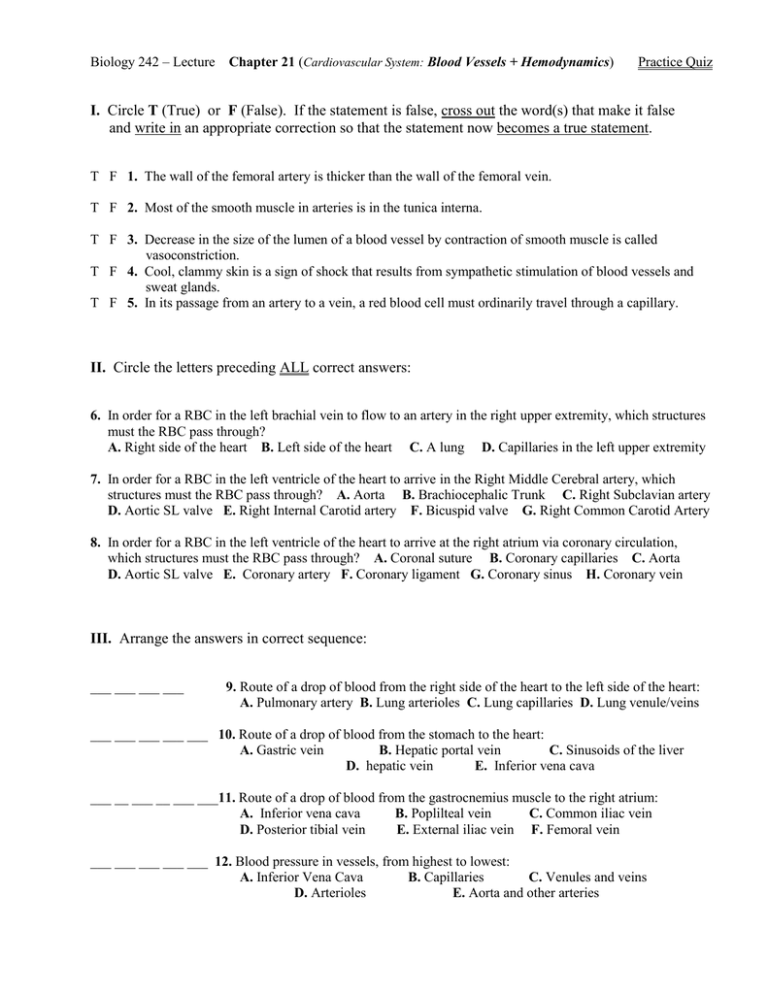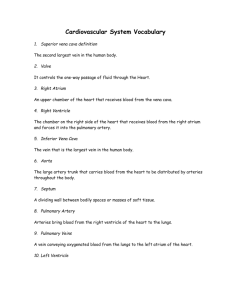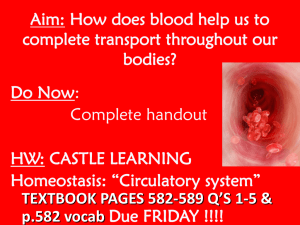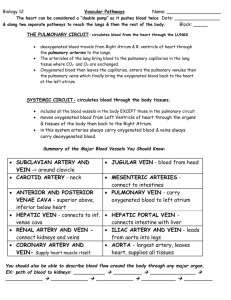I. II. III. and write in an appropriate correction so that the statement...
advertisement

Biology 242 – Lecture Chapter 21 (Cardiovascular System: Blood Vessels + Hemodynamics) Practice Quiz I. Circle T (True) or F (False). If the statement is false, cross out the word(s) that make it false and write in an appropriate correction so that the statement now becomes a true statement. T F 1. The wall of the femoral artery is thicker than the wall of the femoral vein. T F 2. Most of the smooth muscle in arteries is in the tunica interna. T F 3. Decrease in the size of the lumen of a blood vessel by contraction of smooth muscle is called vasoconstriction. T F 4. Cool, clammy skin is a sign of shock that results from sympathetic stimulation of blood vessels and sweat glands. T F 5. In its passage from an artery to a vein, a red blood cell must ordinarily travel through a capillary. II. Circle the letters preceding ALL correct answers: 6. In order for a RBC in the left brachial vein to flow to an artery in the right upper extremity, which structures must the RBC pass through? A. Right side of the heart B. Left side of the heart C. A lung D. Capillaries in the left upper extremity 7. In order for a RBC in the left ventricle of the heart to arrive in the Right Middle Cerebral artery, which structures must the RBC pass through? A. Aorta B. Brachiocephalic Trunk C. Right Subclavian artery D. Aortic SL valve E. Right Internal Carotid artery F. Bicuspid valve G. Right Common Carotid Artery 8. In order for a RBC in the left ventricle of the heart to arrive at the right atrium via coronary circulation, which structures must the RBC pass through? A. Coronal suture B. Coronary capillaries C. Aorta D. Aortic SL valve E. Coronary artery F. Coronary ligament G. Coronary sinus H. Coronary vein III. Arrange the answers in correct sequence: ___ ___ ___ ___ 9. Route of a drop of blood from the right side of the heart to the left side of the heart: A. Pulmonary artery B. Lung arterioles C. Lung capillaries D. Lung venule/veins ___ ___ ___ ___ ___ 10. Route of a drop of blood from the stomach to the heart: A. Gastric vein B. Hepatic portal vein C. Sinusoids of the liver D. hepatic vein E. Inferior vena cava ___ __ ___ __ ___ ___11. Route of a drop of blood from the gastrocnemius muscle to the right atrium: A. Inferior vena cava B. Poplilteal vein C. Common iliac vein D. Posterior tibial vein E. External iliac vein F. Femoral vein ___ ___ ___ ___ ___ 12. Blood pressure in vessels, from highest to lowest: A. Inferior Vena Cava B. Capillaries C. Venules and veins D. Arterioles E. Aorta and other arteries Biology 250 – Lecture Chapter 21 Practice Quiz Page Two IV. Using the blanks provided, fill-in the word or phrase that best fits the description given: ___________________13. This is a weakened section of a blood vessel forming a balloonlike sac. ___________________14. These are four of the arteries that are unpaired (ie not bilaterally occurring) ___________________ ___________________ ___________________ ___________________15. These are three of the veins that have names different from the names of ___________________ of the arteries they accompany, or that have no such accompanying artery. ___________________ ___________________16. These are the principle factors that affect blood pressure: ___________________ ___________________ ___________________17. These are the principle factors that affect stroke volume: ___________________ ___________________ ___________________18. This is the mathematical expression that conveys the way in which Change in the lumen size of a blood vessel affects vascular resistance. V. Brief Explanations: 19. Briefly explain why many pregnant women manifest pregnancy related hypertension. 20. Briefly explain the Frank-Starling law of the heart; and how does this relate to stroke volume?



